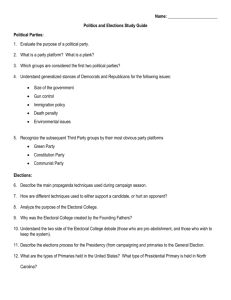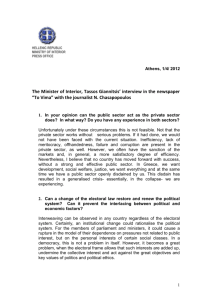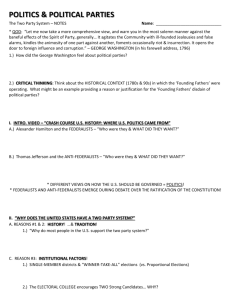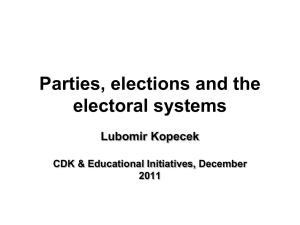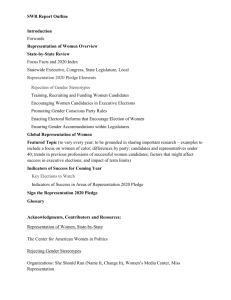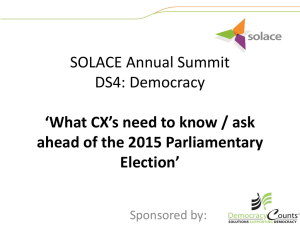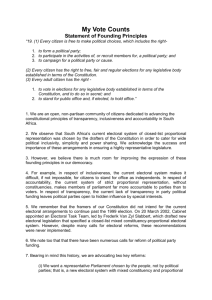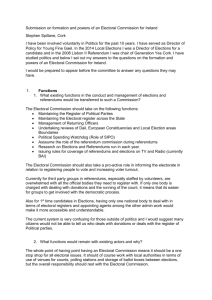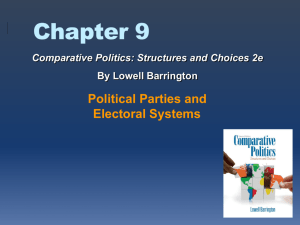PPTX 338 KB - Parliament UK
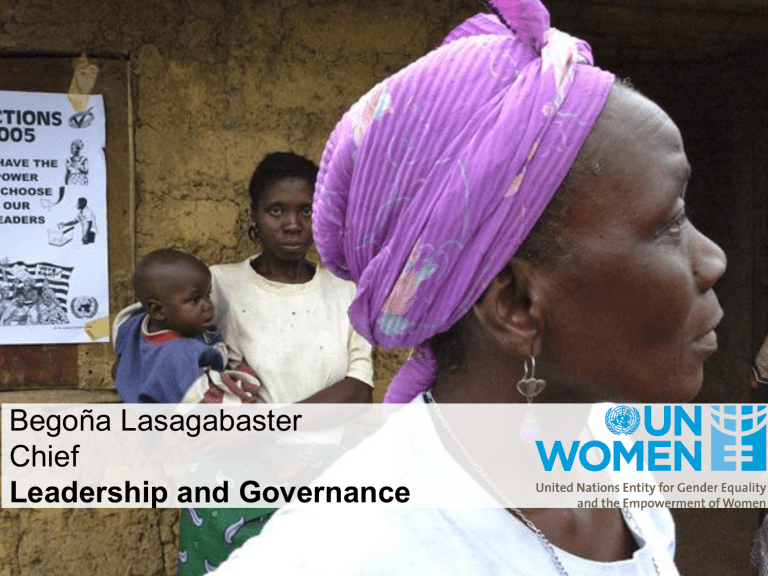
Begoña Lasagabaster
Chief
Leadership and Governance
Political Participation
Women's full participation in the political life of their countries is an essential condition for democracy.
- Michelle Bachelet
Status of Women in Political Participation
IPU – UN Women Map was launched on March 2 nd
[Data from IPU. See www.ipu.org
for further details]
• Currently, women’s average representation is of 20.5% (it has increased since the launch of the map)
• It has been 30 years since the CEDAW Committee. Since then 33 countries have reached the 30% representation target
• Chambers:
– 20 in Europe (5 of which are Nordic countries)
– 13 in Sub-Saharan Africa
– 13 in the Americas
– 4 in Asia-Pacific
• Elected women are less than 10% in 42 countries (and in 6 countries there is no women’s representation – down from 10)
• Out of the 33 countries that have reached 30% or more of women in parliament, 30 have temporary special measures in place.
• Out of the 56 countries that held elections in 2011, 26 have introduced special measures
• An average of 27.4% representation has been achieved in the 17 countries that have legislated electoral quotas
• The average representation is 15.7% in countries that have no quotas at all
• 1/3 of the 30 countries that have reached the 30% target are in the midst of democratic transition/post-conflict
UN Women’s Work on Political Participation
• Elections:
– National Elections: 31
– Local/Municipal Elections: 25
– Voter registration: 4
– Electoral Management Bodies (EMBs): 17
– Electoral law reform: 33
– Specific work on Temporary Special Measures (TSMs): 29
– Training capacity building for candidates: 29
– Civic education on elections: 6
– Ending Violence Against Women in Politics (EVAWiP): 10
• Women’s movements: 53
• Political Parties: 46
• Gender mainstreaming in Governments (such as Gender Responsive Budgeting, collaboration with other ministries, gender mainstreaming of non-elected officials for example): 37
UN Women’s Work on Political Participation
• Gender mainstreaming in Governments (such as Gender Responsive Budgeting, collaboration with other ministries, gender mainstreaming of non-elected officials for example): 37
•
Elections
– National Elections: 31
– Local/Municipal Elections: 25
– Voter registration: 4
– Electoral Management Bodies (EMBs): 17
– Electoral law reform: 33
– Specific work on Temporary Special Measures (TSMs): 29
– Training capacity building for candidates: 29
– Civic education on elections: 6
– Ending Violence Against Women in Politics (EVAWiP): 10
• Women’s movements: 53
• Political Parties: 46
• Media: 19
• Constitutional reform: 15
• Research on leadership and political participation (examples include Gender Responsive
Governance Index to measure improvement in women’s effective political leadership at national and state levels, publications on gender and governance, etc.): 18
• Parliaments/Councils
– Law changes and policies: 21
– Training and capacity building: 43
• Youth: 13
• Electoral law
• Electoral
Management bodies
• Electoral Justice
Collaboration between
Politicians, Civil Society and Academia
Real Gender
Equality Provisions
• Monitoring of communications and media during electoral campaigns
• Opening up dialogue to achieve lasting change
Including women in the top echelons
-obtaining financing at the opportune moment
-Making equality part of political parties and organizations’ agenda (Women’s manifestoes)
Political
Parties
Empowerment of women at the grassroots level in terms of leadership and political participation.
Electoral
M
Systems .
Media
Leadership building
Capacity
Elected
Women
Constitutional reforms
Parliament
• Women’s caucuses
• Building capacity
• Every law has an impact on gender
• Women in all committees
• Gender Unit
INFORMATON Accountability
Civil
Society
• Working on the recording and acquisition of women’s political rights
• Representation of all society: diversity.
• Participation of those women who are most excluded
• Inter-generational dialogue, training of young women.
Government
Justice
• Women’s
National
Machinery
• Critical mass of women
• Women in key positions
• Gender
Budgeting
• Real implementation
• of laws
Building judges’ capacity on gender issues
• Women judges
Challenges
• Pressing need for data on local governance
– Why it matters:
• It is crucial for electoral assistance
• The data is necessary in order to measure any sort of changes
• It is also crucial in order to better understand the professional trajectories of female politicians, who often come from local politics (although not just politics – from other forms of leadership such as school boards, etc.)
• Difficult balance to strike on the rationale behind women’s representation
– Balance to be struck between two perspectives:
• Intrinsic reason: women’s representation as a matter of human rights
• Instrumental reason(s): what does an increase in women’s representation achieve?
– Must also consider the programming balance to be struck between
• Work that aims to increase the numbers of elected women
• Work that aims to improve the quality of legislative decisions from a GE perspective
• What should the advocacy agenda look like post 2015 ?
– What key measures should we advocate for to ameliorate democratic governance?
– What advocacy measures would be best suited to taking the debate towards talk of parity?
